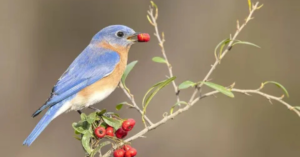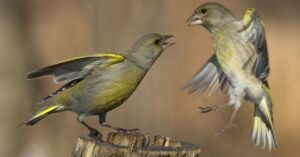As summer blooms and the sweet scent of nectar fills the air, many backyard enthusiasts eagerly set up their hummingbird feeders to attract these dazzling aerial acrobats. Sharing your space with bees—while important for pollination—can quickly turn your serene birdwatching experience into a buzzing frenzy.
If you’ve found yourself asking how to keep bees away from hummingbird feeders without harming these vital pollinators, you’re not alone. From feeder design choices to strategic placement tips, learn how to create an inviting environment for hummingbirds while keeping those pesky bees at bay.
A Hummingbird Predator
Hummingbird feeders can attract not only the vibrant, fluttering birds but also keep away buzzing guests—specifically, hummingbird bees. These industrious insects are drawn to the sugary nectar, often overwhelming the feeder and frustrating those hoping to watch their feathered friends.
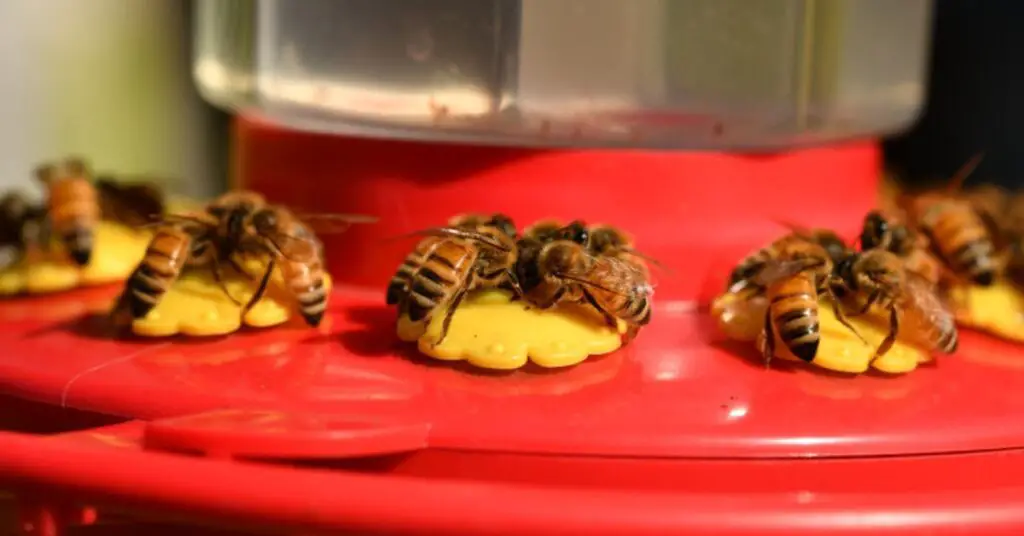
To effectively keep bees off hummingbird feeders, consider using bee guards or specialized feeding ports designed to deter these pests while allowing easy access for hummingbirds. Placing your feeder in a shaded area can also help; bees prefer sunny spots where they can warm up quickly.
Here Are The Tips For How To Keep Bees Away From Hummingbird Feeders
1. Use A Red Hummingbird Feeder
Using a red hummingbird feeder is one of the most effective strategies to keep bees off hummingbird feeders. Bees are naturally attracted to bright colors, and while they’re drawn to yellow and other vibrant shades, a red feeder captures the attention of hummingbirds without appealing as much to bees.
Opting for a feeder with minimal yellow accents can diminish their interest, allowing birds to drink nectar in peace.
2. Get Nectar Guards
One of the most effective solutions to deter bees from your hummingbird feeders is to invest in nectar guards specifically designed for this purpose. A bee-proof hummingbird feeder often features built-in barriers that allow only smaller birds, like hummingbirds, to access the nectar while keeping bees at bay.
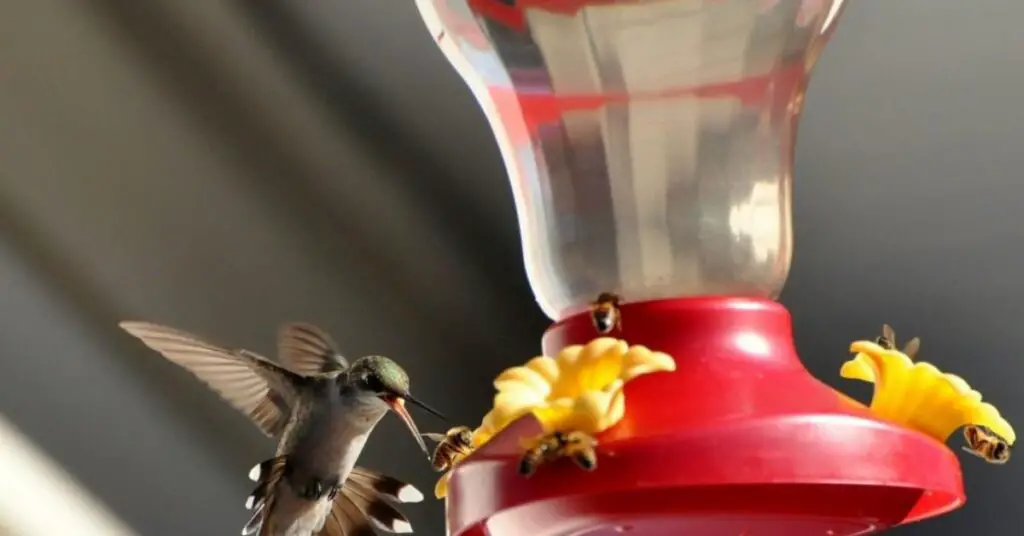
When searching for bee-proof hummingbird feeders, look for options with adjustable feeding ports or removable nectar guards.
3. Plug Leaks
One of the most effective measures in protecting your nectar from bees is to ensure you plug leaks in your bee-proof hummingbird feeder. Even the smallest crack or loose seam can attract bees, turning your charming feeding station into a buzzing hotspot.
Regularly inspect for any signs of wear or damage and promptly seal them to maintain the integrity of your bee-proof hummingbird feeder.
4. Stay In The Shade
One of the most effective strategies to keep bees out of your hummingbird feeders is to position them in shady areas. Bees are naturally attracted to sunny spots where flowers thrive, as these locations tend to feature an abundance of nectar-rich blooms.
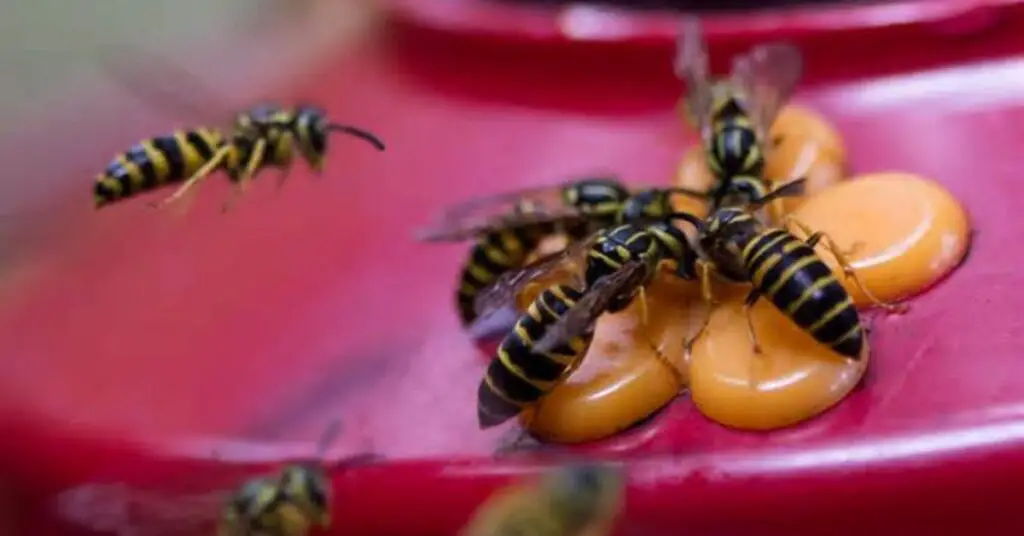
By placing your bee-proof hummingbird feeder in a shaded environment, you create a less inviting atmosphere for bees while also making it more appealing for hummingbirds, which prefer cooler settings.
5. Relocate Frequently
One effective strategy to deter bees from invading your hummingbird feeders is to relocate them frequently. By changing the location of your bee-proof hummingbird feeder, you can disrupt the bees’ established foraging patterns.
This unpredictability keeps them guessing and decreases their chances of discovering a consistent food source. Aim to move your feeder at least every few days, opting for shady areas or spots that are less accessible to pests.
6. Plant A Pollinator Garden
One of the most effective strategies to keep bees out of your hummingbird feeders is to create a pollinator garden that naturally attracts bees away from your feeders.

By strategically placing these specialized feeders in tandem with your colorful pollinator garden, you not only provide a dedicated buffet for both types of creatures but also enhance the overall beauty and biodiversity of your outdoor space.
If you liked our post, you’ll enjoy our other post: “How Do I Keep Insects Off My Hummingbird Feeder?“
Conclusion
Keeping bees away from your hummingbird feeders is essential for ensuring that these delicate creatures can enjoy their nectar without competition. By implementing strategies such as using bee guards, placing feeders strategically, and opting for bee-repellent alternatives, you can create a more inviting environment for hummingbirds. Maintaining cleanliness around the feeder will help minimize the attraction of bees.
FAQ’s
How Do You Keep Bees Away From Hummingbird Feeders?
Ensure that the sugar-water solution you use for the hummingbirds is clean and well-maintained. Bees are attracted to spills and residues, so regularly clean your feeder and avoid overfilling it.
Positioning your feeder in a shaded area can also help; bees tend to prefer sunny spots where they can easily forage.
Why Are There So Many Bees Around My Hummingbird Feeder?
Bees are often attracted to hummingbird feeders because they contain sugar water, which is a primary source of energy for these pollinators. The sweet nectar mimics the natural floral sources that bees typically seek out.
How Do I Protect My Hummingbird Feeder?
One of the most effective ways to protect your feeder is by placing it in a location that minimizes exposure to predators. Hang the feeder in an open area, away from dense shrubs or trees where cats and other animals might hide.
What Scent Keeps Bees Away?
Bees are generally attracted to floral scents and sweet aromas, but certain scents can deter them. Essential oils such as peppermint, eucalyptus, and citronella oils are known to keep bees at bay.
- How To Keep Bees Away From Hummingbird Feeders - March 20, 2025
- How To Attract Owls To Your Yard - March 11, 2025
- Breeding Season For Wild Birds - March 9, 2025

